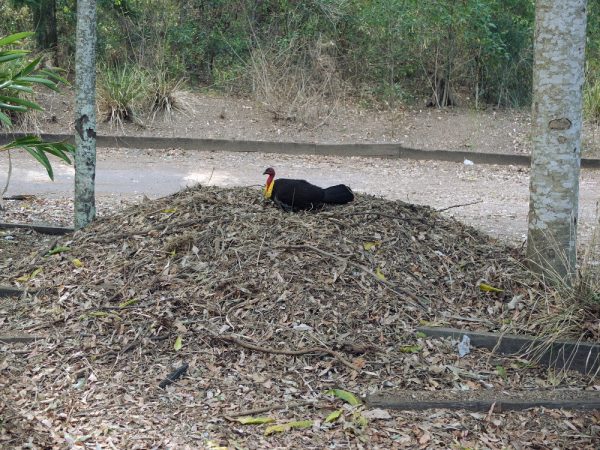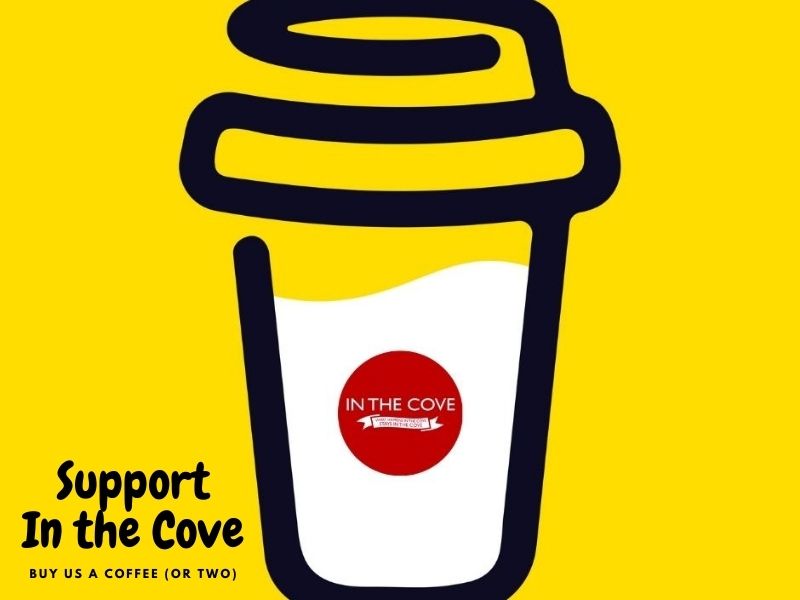Way back in 2017 we were contacted by a researcher at Sydney University asking if we could post a survey about Brush Turkeys (we used to call them Bush Turkeys but apparently that is wrong). Our Facebook Feed went off with people saying what a fabulous bird they are and others saying they just destroy gardens. People noted that there are more and more brush turkeys around.
In June 2022 the Sydney Morning Herald published an article about how Brush Turkeys have changed their habits. It was noted the turkeys were “Demonstrating a behaviour eerily reminiscent of their Jurassic ancestors, a pack of brush turkeys has been filmed in Sydney’s Northern Beaches ravenously devouring the carcass of a bandicoot.”
What is a brush turkey?
The brush turkey is easily recognised by its:
- deep blue-black plumage
- bright head colours
- broad, flat tail
- general turkey-like appearance.
The bird’s wattle (a fleshy lobe hanging down from the base of its neck) varies in colour with its age, gender and location. In the southern parts of its range, the male brush turkey has a bright yellow wattle, while on the Cape York Peninsula in far north Queensland, its wattle is light blue. Females and younger birds have dull yellow wattles.
Brush turkey chicks look much like quails, with plain rich brown feathers over their entire bodies. As they mature, they lose the feathers on their heads and necks, where the bare skin turns a deep pink colour.

Protected Species
Brush Turkeys really are the Marmite of birds. You either love them or hate them.
The Brush Turkey is a protected species and since it became protected, there has been a huge increase in the number of turkeys in South East Queensland (over 700% increase) and an increase on the North Shore of Sydney.
Each year, the Lane Cove Council holds a Living with Brush Turkeys seminar. We will let you know when the next one is scheduled.
If you attend the seminar you will receive tips on how to live harmoniously with this fascinating bird with expert Ann Goeth, author of “Mound Builders”. You will take a closer look at the unique life of the Australian Brush-turkey, their foraging habits, breeding and why they build such large mounds!
German-born scientist Ann Goeth – is one of the world’s leading experts on the Australian Brush Turkey – she strongly believes that the Brush Turkey is one of the most interesting birds on the planet. We have it on good authority that Ann does not live on the North Shore – so she may not have an invasion in her garden.
If you can’t get to the seminar but want to know more, Ann Goeth has written a book on living with brush turkeys – you can purchase it here.
Behavioural ecologist Professor Darryl Jones said nothing – not cats or cars – was stopping the rise of the birds. In fact, each female lays 30 eggs a year. Professor Jones told the ABC, “Sydney can expect an avalanche in the next 20 years of more and more brush turkeys because they love it – somehow or other they survive.”
Experts have advised that you can protect your garden by making it hard for the birds to scratch the ground covering – for example, replace mulch with pebbles or rocks or peg chicken wire over areas you want to protect. If you really love a plant cover it with netting.
In Lane Cove the struggle is real – this is what one resident told us:
I have lived in the Lane Cove area for 30 years and love this leafy green suburb. I have families of Kookaburras, Currawongs, Magpies, Lorikeets and Aussie Minors that visit my kitchen door daily for hand held treats.
However, over recent years my property has been systematically destroyed by Brush (Bush) Turkeys.
It started with one, we now have six fossicking adults!
I have called W.I.R.E.S, Lane Cove Council, even Graham Ross from the Garden Clinic Club (and Better Homes & Gardens). But to no avail. These marauding pests are protected!
I don’t have a five-acre block where I can spare a corner for these looting pests to destroy. My once beautiful and productive small vegetable and native garden is now a raped, barren piece of dirt.
Once the male turkey has established his mound that’s home forever. Females visit, lay up to 100 eggs and move on to the next mound, leaving the male to monitor the heat (33C) until the eggs hatch. The heat of the mound attracts rats, mice and snakes.
Each day the turkey drags more of my garden (dirt, plants, rocks etc) across the street to build a mound in the front yard of a young couple’s home (opposite). They have two children under 3 years. They are frantic and have asked Lane Cove Council to help by removing the mound. But no… these rats with wings are protected!
The street is now littered with on-going debris from my garden making it dangerous to drive down. Every day we sweep the debris back, the turkey returns and pulls it across the street. This goes on and on and on.
I’ve read in past issues (NST) that locals think these tick-carrying, fuzzy-wuzzy-bald-headed eagles are “cute”. Do these admiring Pollyannas know what’s lurking inside when their children play around the mound!
Pigeons, Indian Minor birds even Cockatoos have been culled when their numbers reached plague proportions, and of course our national emblem, the Kangaroo is culled when numbers soar.
Brush Turkeys, like their Queensland mates – the Cane Toad, are in plague proportions.
Their numbers have soared, why are they protected? Surely common sense should prevail!
So what do you think? Are they a welcome addition to leafy Lane Cove or just a pest?
Cover Photo Credit Kris Egan
Help Support Local and Independent News
You can support us in three ways:
- If you own a local business or a Lane Cove resident who owns a business, you can advertise with ITC – our packages start from a $35 monthly fee (for a 12-month commitment). Email us here for our rates card.
- Buy the ITC team a coffee – our office is nearly every coffee shop in Lane Cove, and we regularly meet locals at coffee shops – buy the ITC team a coffee (or two) here.
- Become an ITC reader sponsor – Feel free to be a reader sponsor if you have enjoyed our local news coverage – no amount is too small or too big. Thank you so much to the people who have already supported us via our press Patreon account. Help Us Here.















